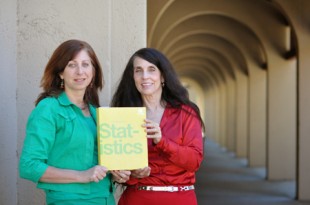MEDIA CONTACTS:
David Ruth
713-348-6327
david@rice.edu
Jade Boyd
713-348-6778
jadeboyd@rice.edu
OpenStax College offers sixth textbook, Introductory Statistics
Rice University-based publisher adds to catalog of free, high-quality textbooks
HOUSTON — (Dec. 12, 2013) — Free textbook publisher OpenStax College has added a sixth title to its growing catalog, which has already saved students more than $5 million. The Rice University-based nonprofit today launched Introductory Statistics, a revised and updated version of the free textbook that first authenticated its core open educational publishing methodology.
Introductory Statistics, which is available for download today, is a new version of the free textbook Collaborative Statistics. The latter was released as a free online textbook in 2008 via Connexions, the parent organization of OpenStax College. Introductory Statistics is also the first OpenStax College title to debut with a full suite of ancillary learning materials — including online homework, quizzes and tests — from a third-party partner.
“This is the book that started it all,” said Rice Professor Richard Baraniuk, the founder and director of both Connexions and OpenStax College. “Collaborative Statistics was the proof-of-concept for OpenStax College. It showed that the philanthropic model for open-education was a viable way to make college more affordable.”

De Anza College faculty members Barbara Illowsky (left) and Susan Dean, co-authors of one of the most popular free online statistics textbooks, display their latest book, Introductory Statistics, the newest title in OpenStax College's growing catalog of free textbooks. Credit: Julie Ceballos/De Anza College
With philanthropic support from the Maxfield Foundation, Connexions purchased the rights to Collaborative Statistics — a popular printed textbook written by Barbara Illowsky and Susan Dean — and made it available in its online repository of free learning materials. The book was eventually adopted by more than 60 instructors in a dozen states and has been used by thousands of college students.
OpenStax College uses a similar “venture philanthropy” model. The publisher raises money from foundations to underwrite the costs of producing high-quality textbooks that it publishes online free for all college students and instructors. OpenStax College’s catalog includes titles for introductory physics, sociology, anatomy and physiology, and both majors and nonmajors biology. In less than two years, educators teaching some 52,000 students at more than 360 community colleges, four-year colleges and research universities have adopted the books.
Introductory Statistics is the first OpenStax College book to be based on an existing Connexions title. The original authors, math professors Illowsky and Dean from De Anza College in Cupertino, Calif., helped create the new version, while Dean led the overall revisions.
Dean, who is now retired, said she agreed to work with OpenStax College to co-author Introductory Statistics because she “wanted to make sure the book kept its original simplicity and kept the writing directed at the students.”
“It uses technology and collaboration, and I wanted these two things to remain,” said Dean, who taught math at De Anza for more than 20 years. “I also really believe in increasing access to education and providing good online books that are available free to students.”
Illowsky, a tenured professor of mathematics and former department chair at De Anza, where she has taught since 1989, said Introductory Statistics is particularly strong in areas where students need it most.
“The students who take this course will be in careers where they need to understand if a survey is biased, what it means for events to be independent, how to interpret ‘statistically significant’ and how to understand relationships,” Illowsky said.
David Harris, editor-in-chief of OpenStax College, said all the material in Collaborative Statistics was put through OpenStax College’s editing and peer-review process. As a result, Introductory Statistics contains improved art and has been expanded to cover the standard scope and sequence of a typical introductory statistics course.
Harris said another draw for the new book is the wealth of ancillary materials that are available to instructors who wish to use it in their class. Those materials include PowerPoint slides as well as a slate of low-cost add-ons from OpenStax College partner WebAssign.
“Instructors are looking for a well-rounded product offering when they choose a book,” Harris said. “We are partnering with WebAssign to provide these products for Introductory Statistics, and we are working with a number of other for-profits to develop resources for our other titles.”
OpenStax College launched in February 2012 and is made possible by the generous support of the William and Flora Hewlett Foundation, the Laura and John Arnold Foundation, the Bill and Melinda Gates Foundation, the 20 Million Minds Foundation, the Maxfield Foundation, the Calvin K. Kazanjian Foundation and the Leon Lowenstein Foundation. OpenStax College plans to add introductory texts in five more subjects — precalculus, chemistry, economics, U.S. history and psychology — by 2015.
For more information, visit http://openstaxcollege.org.
-30-
The following VIDEOS are available at:
OpenStax College: What is the impact of a free book?
http://www.youtube.com/watch?v=XgeA9h2c7ag
A high-resolution IMAGE is available for download at:
https://news2.rice.edu/files/2013/10/1014-STATS-authors-lg.jpg
CAPTION: De Anza College faculty members Barbara Illowsky (left) and Susan Dean, co-authors of one of the most popular free online statistics textbooks, display their latest book, Introductory Statistics, the newest title in OpenStax College’s growing catalog of free textbooks.
CREDIT: Julie Ceballos/De Anza College
Located on a 300-acre forested campus in Houston, Rice University is consistently ranked among the nation’s top 20 universities by U.S. News & World Report. Rice has highly respected schools of Architecture, Business, Continuing Studies, Engineering, Humanities, Music, Natural Sciences and Social Sciences and is home to the Baker Institute for Public Policy. With 3,708 undergraduates and 2,374 graduate students, Rice’s undergraduate student-to-faculty ratio is 6-to-1. Its residential college system builds close-knit communities and lifelong friendships, just one reason why Rice has been ranked No. 1 for best quality of life multiple times by the Princeton Review and No. 2 for “best value” among private universities by Kiplinger’s Personal Finance. To read “What they’re saying about Rice,” go to http://tinyurl.com/AboutRiceU.

